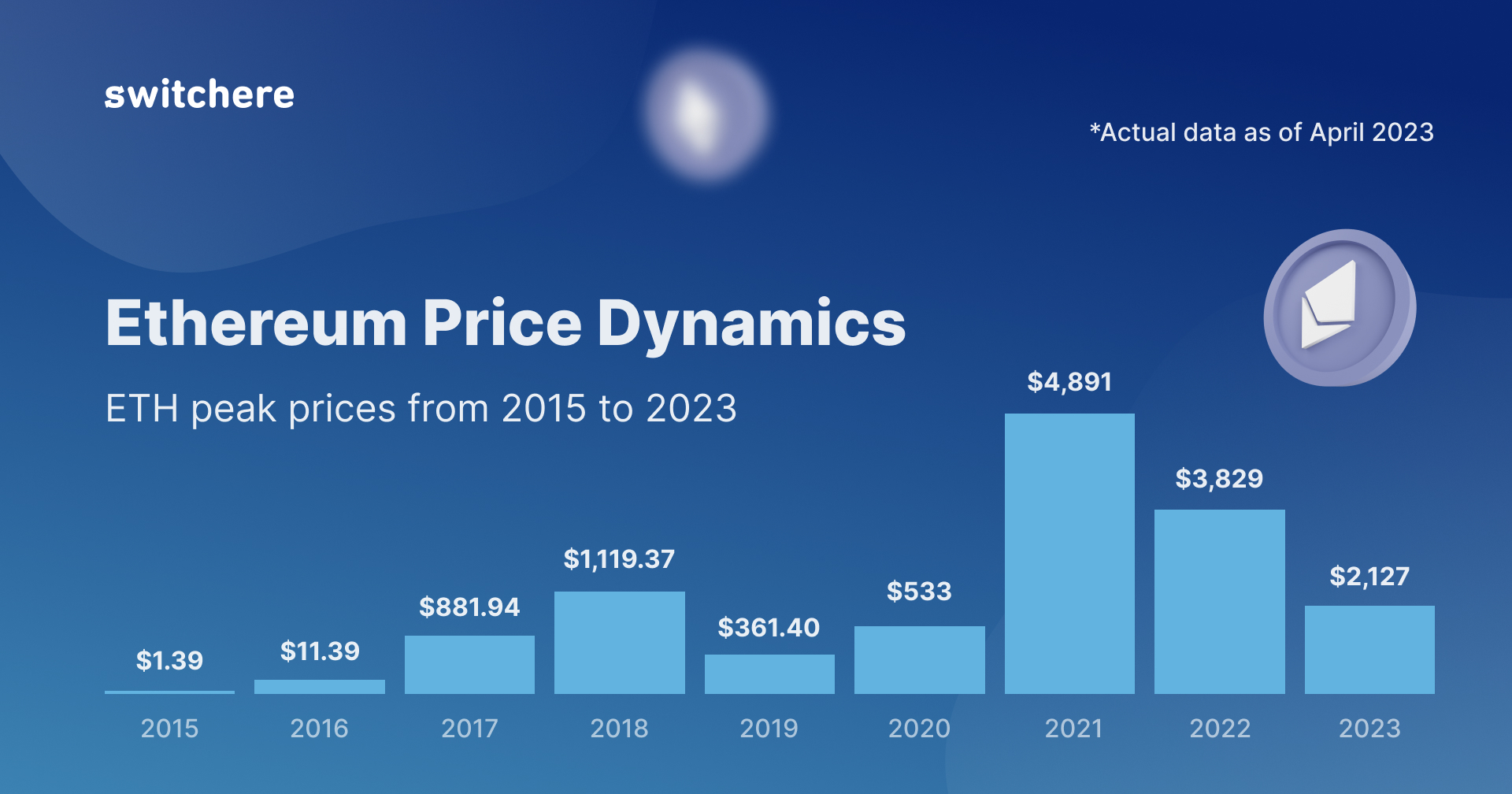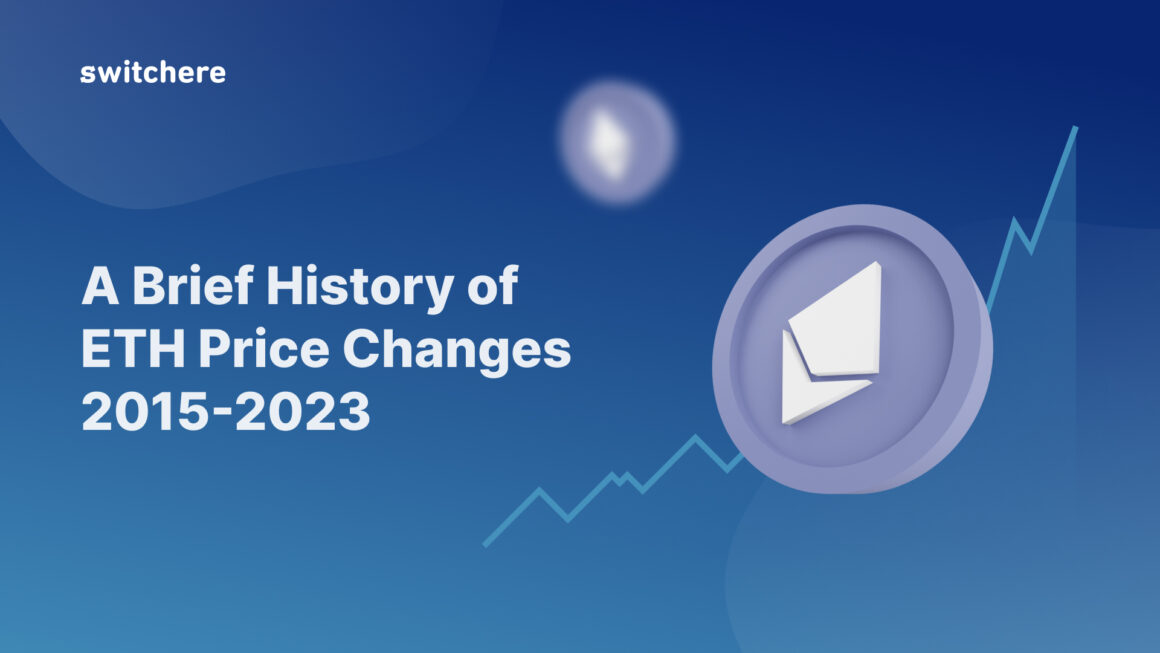The second-largest cryptocurrency by market cap, created by programmer Vitalik Buterin, has successfully passed all the market tests. Still, the Ethereum (ETH) exchange rate dynamics have changed sharply more than once. Today, we’ll consider the history of Ether price changes and talk about its local peaks, lows, and other important events in the cryptocurrency network. Let’s get started!
Ethereum Price History by Years
Ethereum is the second most popular cryptocurrency and, perhaps, the major competitor to Bitcoin. The coins are called Ether and stand for ETH.
The history of Ethereum began in 2013, when 19-year-old Vitalik Buterin, co-founder of Bitcoin Magazine, first presented his vision for the next-gen crypto platform.
The main value of Ethereum consisted not so much in Ether coins as in smart contracts. These are programs on the blockchain that transfer regular contracts to their digital version. In this case, transactions are monitored by a computer, not a person.
As an example, the coin’s creators cited the simplest sweepstakes: two network participants bet on the outcome of a football match. After its completion, a smart contract is executed, and the automatic distribution of winnings takes place according to the specified algorithm.
The fundraising campaign for the development started in 2014. In total, the developers were able to attract investments for almost 31,550 bitcoins. After that, Vitalik Buterin and the team started the development of their projects.

ETH Price History: Network Launch
The first active release to the public was presented on July 30, 2015 — on that day, the Ethereum blockchain, distributed digital base, was launched. The protocol was #1 and was named Frontier. All this time, Vitalik Buterin was engaged not only in the development but also in the active promotion of his cryptocurrency — as a result, Ethereum has been able to build partnerships with major companies, including Microsoft.
According to the Etherscan.io website, the first surviving historical records regarding the value of Ethereum date back to August 7. On this day, ETH was added to the Kraken crypto exchange and was valued at $2.77 per coin. Over the next three days, the price fell four times to $0.68, most likely due to rapid sales organized by early investors.
However, by August 13, 2015, investors’ interest boosted the cryptocurrency rate to unprecedented heights — $1.8, and the coin’s rate maintained at this level for three days. As all-time Ethereum charts show, the next local Ether peak was recorded almost six months later.
Meanwhile, another significant event for the cryptocurrency network fell on August 18 — on that day, miners successfully mined the first 100,000 blocks. Still, by this time, the ETH rate had fallen to $1. Then, over the course of two months, the price of Ethereum gradually decreased.
During this period, more and more crypto enthusiasts learned about Ether. The conference made an important contribution to its popularization for Devcon-1 developers, where representatives from IBM, Microsoft, and UBS were present.
Ether Price in 2016: The Dark DAO
In March 2016, the protocol was changed. The second version was called Homestead, and the developers positioned this version as stable. Notably, Ether’s price in the first 2.5 months of 2016 increased by more than ten times. By this time, the total market cap of the network had reached $1 billion. The project enjoyed wide popularity, but the history of the ETH exchange rate turned in an unexpected direction.
Right after the hard fork, a serious correction of the coin rate began. As a result, the price of Ether had halved to $7.3 by the end of April.
The next event that boosted the price of Ethereum to its highest value for the whole year ($21.25) was the massive media coverage of the DAO project’s success, which raised over 12 million ETH (~$150 million) as part of the token sale.
But a temporary triumph turned into a local disaster since the DAO contained a dangerous vulnerability that the scammers took advantage of. On June 16, 2016, they managed to transfer about $50 million under their management. By June 18, the ETH exchange rate had fallen by more than 30%.
The Ethereum Foundation team, led by Vitalik Buterin, had to solve the difficult task of maintaining the ETH rate and the ecosystem’s stability.
Ultimately, everything resulted in the proposal of a new hard fork and the retrieval of the stolen funds to the fund. However, the innovations were met with resistance from a part of the cryptocurrency community.
As a result, representatives of the fund managed to push through their proposals, and in mid-July 2016, a hard fork took place, during which the database was corrected, and the stolen funds were returned.
It was a historic moment. The very part of the community that did not want to change the rules created a new project — Ethereum Classic. This network has developed independently, positioning itself as free from censorship, fraud, and outside interference.
In mid-September, against the backdrop of news about adding Ethereum support to the Ledger Nano S hardware wallet, the ETH exchange rate increased to $15.
Still, on September 22, Ethereum faced a DDoS attack, which slowed down the network significantly. This news was the impetus for the beginning of a local downtrend, which lasted 2.5 months and ended on December 5. Until the end of the year, the rate consolidated in the price range of $7-9.
Bull Trend in 2017
At first, the Ether exchange rate in 2017 grew quite smoothly and steadily, reaching $13 per coin by February 23. The move up accelerated after the coin was added to the eToro social platform for traders.
On the same day, the number of unconfirmed transactions in the Bitcoin network reached 100,000. More and more crypto investors, who consider Bitcoin slow and outdated, were looking for alternative options for investing. A considerable part of them turned their attention to Ether.
In March, Ethereum rose to $40-50 and maintained at this price range until the end of April. Around the same time, the number of unconfirmed Bitcoin transactions exceeded 200,000. One of the reasons is that many miners switched to Ethereum mining.
The combination of these two significant factors led to a two-fold increase in the coin’s price — on May 5, 1 ETH already cost $95.
In May, the coin was added to the AVATRADE trading platform, and its price quadrupled in less than a month. Investors who bought Ethereum six months ago were able to sell it for 50 times more. Thus, the Ethereum exchange rate dynamics brought them a double profit.
Many analysts attribute the bullish trend to the widespread popularity of the coin in the crypto community and the dApps developer environment. The ICO hype also contributed to the increased demand for Ethereum — thousands of projects have chosen ETH as the main currency for accepting payments in the process of token sales.
After such rapid growth, a correction phase followed, ending at the end of July at around $150. Until mid-November, the price of Ethereum consolidated in the $275-350 range, periodically testing new support levels.
The growth peak took place in December when the ETH rate reached $800. Further, like most cryptocurrencies on the market, Ether corrected in parallel with the 80% drop in the Bitcoin rate and temporarily fell to $500-600.
Bear Trend in 2018
It seemed that in 2018 the rapid growth of Ethereum would continue, and on January 13, the maximum exchange rate of Ether was fixed at $1,400.
By mid-February, the Ethereum exchange rate had dropped to $900. But after the developers announced the release of the new Ethereum Go client, Iceberg, it had grown to $1,000. From that moment until mid-September, the ETH rate was unstable and ranged from $380 to $830 per coin.
The era of ICO, which provoked the rapid growth of the Ethereum rate in 2017, had come to an end. Thousands of ICO projects sold their savings in ETH, pushing its rate down.
The fall slowed down in early September at around $180, and until mid-November, the rate ranged between $200 and $300. However, in November, Bitcoin reached the $6,000 level and almost halved in price within a month.
The Ethereum rate fell to $85, and Ripple (XRP) took the second position in the cryptocurrency top. The bearish year for Ethereum ended at an absolute low of $140, and the coin’s rate fell tenfold.
2019: Return to Last Year’s Price
In the first week of January, Ethereum returned to the second position in the CoinMarketCap ranking, and its value reached $160. By this time, the rates of almost all altcoins synchronized with the price movements of Bitcoin. The local highs during this time were $160 and $180.
In April and May, the bitcoin rate rose by almost $2,000, but no significant changes were observed in the cryptocurrency market. At the peak of growth, Ethereum cost $280-300, but it fell back to its usual rate of $145 by the end of the year.
New ETH Highs in 2020
The key and most anticipated event for Ethereum holders was the launch of phase zero of Ethereum 2.0. In December, users were able to deposit their ETH to the Ethereum 2.0 deposit contract. Storing coins on this contract allowed investors to receive passive rewards for staking the coin.
In 2020, Ethereum had risen in price by 460%. So, at the beginning of the year, on January 1, the main altcoin cost $130. In February, the price of Ethereum rose to $290 but then began to decline along with BTC. In March, the coin rate fell below $90. After that, a new uptrend began, and Ethereum ended the year above the $1,200 mark.
Ethereum Price Dynamics in 2021
The altcoin easily broke its former price record in January 2021. In February, it came close to the $2,000 mark. In mid-April, Ethereum overcame the psychologically important milestone of $2,500. The driver for the price jump was an important network update — the creators carried out the Berlin hard fork, which was part of the transition plan to Ethereum 2.0. The new absolute price peak fell on May 12, when the price of ETH exceeded $4,891.
This is the highest value of Ethereum of all time. At the same time, the market cap of Ethereum also set a new high of $500 billion, which was equivalent to about 20% of the total cryptocurrency market.
Crypto Winter in 2022
At the beginning of the year, Ether was worth more than $3.7K. However, by January 9, the value of ETH had fallen to $3K. Then the cryptocurrency market reacted to the US Federal Reserve System (FRS) meeting. At this meeting, the regulator planned to repeatedly increase interest rates and reduce the balance sheet of the country’s central bank by $8.3 trillion.
Ethereum approached the $3.8K mark only a few months later. The cost of ETH reached $3.5K on April 4, 2022. Over the following months, Ether showed a fall. On June 19, the price of ETH reached $984 in the moment, and on August 4, 2022, the price of Ether recovered to $1,681.4.
Since the beginning of 2023, the Ether began to grow. So the cost of altcoin rose from $1,000 to $1,895. Today, on April 18, 2023, the price of ETH is $2,099; that is, the rate has approximately halved over the year.
Final Thoughts
Will the situation change significantly in 2023? Well, only time will tell. Today, we have considered the history of ETH price changes.
If you’re interested in buying Ethereum, you should definitely think about doing it at Switchere. On our platform, you have an opportunity to buy ETH in the fastest and most convenient ways using any available payment method. Moreover, we offer some surprising bonuses! Users of our platform enjoy a 0% service fee for the first order.
Read Next: How to Buy Ethereum (ETH): A Step-by-Step Guide 2023

Leave a Reply